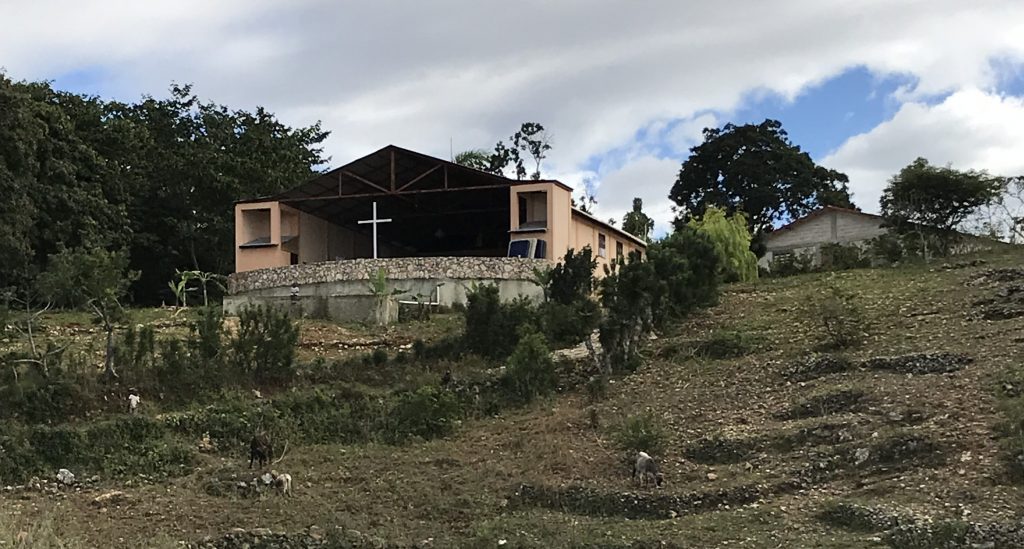Concrete block walls, topped with razor wire and broken glass, raced by the whitewashed cage as our driver downshifted into the corner throwing us, his cargo, hard against the wooden bench. Dented pickups and SUV’s jostled in both directions between clusters of locals all hemmed by the tight packed houses opening up only sporadically to bright, rubble filled lots or dark alleys. The grit of dust and the acrid fumes of burning plastic mixed in the air with the smells of fermenting fruit, unfiltered diesel and human waste. The coarse chaos of daily life, entirely alien to our American sensibilities, grabbed us roughly. #Kotters, gentlemen. Welcome back to Haiti.
Conditions: 90 degrees and tropical upon arrival, cooler on ChaCha Mountain
TheThang:
February 3rd, 2018 – Saturday
Apple, Chaser and YHC met up at CAE, Columbia’s airport, for our short 9:00 AM flight to ATL where we were to meet Iggy and head on toward Port au Prince, Haiti. Chaser had planned ahead by topping off his water bottle, which TSA graciously pointed out upon searching his bag, an inconvenience he was doomed to repeat. Otherwise our travel plans were uneventful, pleasant even as we enjoyed a cold beverage or two and burgers all around in the Atlanta E terminal… a last meal of sorts.
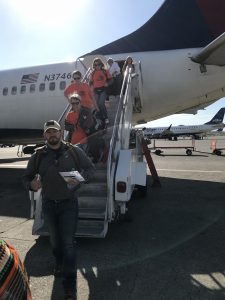 Landing in PAP, our first curve ball was the comical exiting of the plane at the rear. Iggy somehow managed to be the last human aboard, the penalty for his exit row seat exactly halfway between the two actionable doors from the 737. Customs and baggage claim, YHC’s least favorite part of the Haiti experience, was routine as bribes were paid at the various checkpoints (kidding… sort of… the hustle is technically legit) and we were collected as we exited the airport and spotted the very welcome face of Huggy Bear who had already spent a week in Haiti ahead of our arrival.
Landing in PAP, our first curve ball was the comical exiting of the plane at the rear. Iggy somehow managed to be the last human aboard, the penalty for his exit row seat exactly halfway between the two actionable doors from the 737. Customs and baggage claim, YHC’s least favorite part of the Haiti experience, was routine as bribes were paid at the various checkpoints (kidding… sort of… the hustle is technically legit) and we were collected as we exited the airport and spotted the very welcome face of Huggy Bear who had already spent a week in Haiti ahead of our arrival.
We were loaded into the back of a flatbed truck that had been modified with wooden benches down each sidewall and an expanded metal cage built around the back. It’s a normal way to get around Haiti… in the back of a truck modified to receive passengers. And traffic was fairly light as we raced from the airport to the guest house operated by Haiti Under God, our boots on the ground organization that makes the whole trip possible. Huggy Bear, serves as the chair of that board making his presence a critical element to the trip.
The guest house is really quite nice. The property is bounded by a high wall, as are all nicer properties in Port au Prince, and guarded by two dogs… Mr. Brown and Mr. Black. Apparently the Dr. Seuss reference to those names is entirely coincidental. Mr. Brown is a junkyard dog, a mix of pit, rot and several other vicious canine varieties. Mr. Black appears to be a wolf though he’s got enough German shepherd in him to be somewhat domesticated. Indoors there’s a dining room off the kitchen, five or six bedrooms perfectly suited to sleeping two to six guests like us each, a generator out back for when the power’s off and indoor plumbing allowing for showers and the flushing of toilets. Phyll takes good care of the place and of us, when we’re there, with the help of a number of more local staff who make sure we’re well fed.
As the sun descended, we settled in, repacked our gear, checked into social media and made calls home while we could. The next day we were headed out of Port au Prince and up into the mountains so the beds, the sheets, the shower, cold though they always are, were creature comforts to be enjoyed.
February 4th, 2018 – Sunday
In spite of the plush accommodations, local life got the better of some of the pax as a raging party was held that night next door and, with the open windows of the guest house, the dance mix volume was unbearable. Coupled with the barking of Brown and Black plus the rousing sounds of roosters around the neighborhood most of us were up and down throughout the night. Nevertheless, the sun rose in spectacular fashion and, after one last shower, the crew loaded up into pickups to the drive east out of Port au Prince. 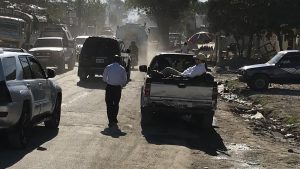 In the cool morning air, riding atop the luggage, the five of us enjoyed a reasonably quick two hour drive, headed east toward the Dominican Republic, before turning south onto a dirt road and heading up to the Valley of Hope Church.
In the cool morning air, riding atop the luggage, the five of us enjoyed a reasonably quick two hour drive, headed east toward the Dominican Republic, before turning south onto a dirt road and heading up to the Valley of Hope Church.
The Valley of Hope Church was originally built by Haiti Under God under the guidance of Paster Maxeau Antoine. It was there we headed for church Sunday morning. Arriving somewhat late (‘late” by Hatian standards is nebulous) we were seated in the choir… a place of distinction for honored guests. We were called up and introduced, all through a translator, and had the privilege of clapping along to the exuberant worship of the local people.
Humbling, the sermon that morning was on Romans 5:3-4, “…we rejoice in our sufferings, knowing that suffering produces endurance, and endurance produces character, and character produces hope…”. Here we were, Americans ridiculously prosperous back home by Haitian standards, listening to a sermon about suffering and endurance and character and hope from a local pastor who probably lives on less each year than it cost for us to fly down to visit. We’d spent the morning complaining about a party the previous night that had robbed us of our beauty rest. These kind people, many wearing their only nice, clean clothes having slept on mats the night before in cramped concrete block houses (if that) and who may or may not have eaten yet that day, welcomed us as friends and brothers in spite of the vast differences between us. What a great message to start the week.
As the service wrapped up we headed back to the trucks, our long journey through Haiti only half complete. From The Valley Church our destination loomed above us, the ChaCha mountain village we were to spend our week serving. 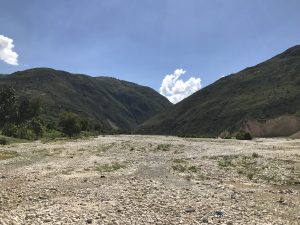 Bumping along further up that dirt road to a broad, rocky riverbed 600 yards across and criss crossed by creeks and gullies, we negotiated on our way to Jacquet, a small village at the base of the climb up ChaCha. The 3000 foot climb from there, over a six mile stretch of rocky and rutted road, was a further removal from everything we are familiar with. As we drove, the valley through the heart of Hispanola, spanning from Port au Prince to the sound of the Dominican Republic, could be seen as our perspective rose higher and higher. Finally, after a day and a half of travel, the ChaCha mountain church came into view with its’ white cross and open amphitheater opening back across the valley.
Bumping along further up that dirt road to a broad, rocky riverbed 600 yards across and criss crossed by creeks and gullies, we negotiated on our way to Jacquet, a small village at the base of the climb up ChaCha. The 3000 foot climb from there, over a six mile stretch of rocky and rutted road, was a further removal from everything we are familiar with. As we drove, the valley through the heart of Hispanola, spanning from Port au Prince to the sound of the Dominican Republic, could be seen as our perspective rose higher and higher. Finally, after a day and a half of travel, the ChaCha mountain church came into view with its’ white cross and open amphitheater opening back across the valley.
(Another team from Columbia, SC visiting ChaCha a week before we arrived, filmed a video using a drone and posted it on YouTube. See: https://youtu.be/Aaztxc0_OWs)
The village on top of ChaCha mountain is hard to describe. There are almost no flat spots, the peak of the mountain, a mere hundred yards above and to the west of the church building, which serves as the center of the community, is bare and wind-swept. There are no cars but for the vehicles we came up in and so there are no roads apart from the main rocky track once cut into the mountain by a USAID outfit that gives access to the area from the valley below. Houses are connected by trails without regard for property lines or any sort of planning. Trees grow wherever they haven’t been cut, many of them banana trees bearing green fruit. Planting fields are defined by rocky mounds around the sides and further by spiked plants used to help define one person’s plot from another. There is no electricity. Water is available only from the church cistern, a covered swimming pool size hole in the ground filled from the gutters and downspouts attached to the church building. There’s a shower stall in the back of the church… but no shower head. There are toilets (I suspect for us) but no way to flush them. A bucked dumped in the shower or in the commode is the source of water for both… though where that water goes is anyone’s guess.
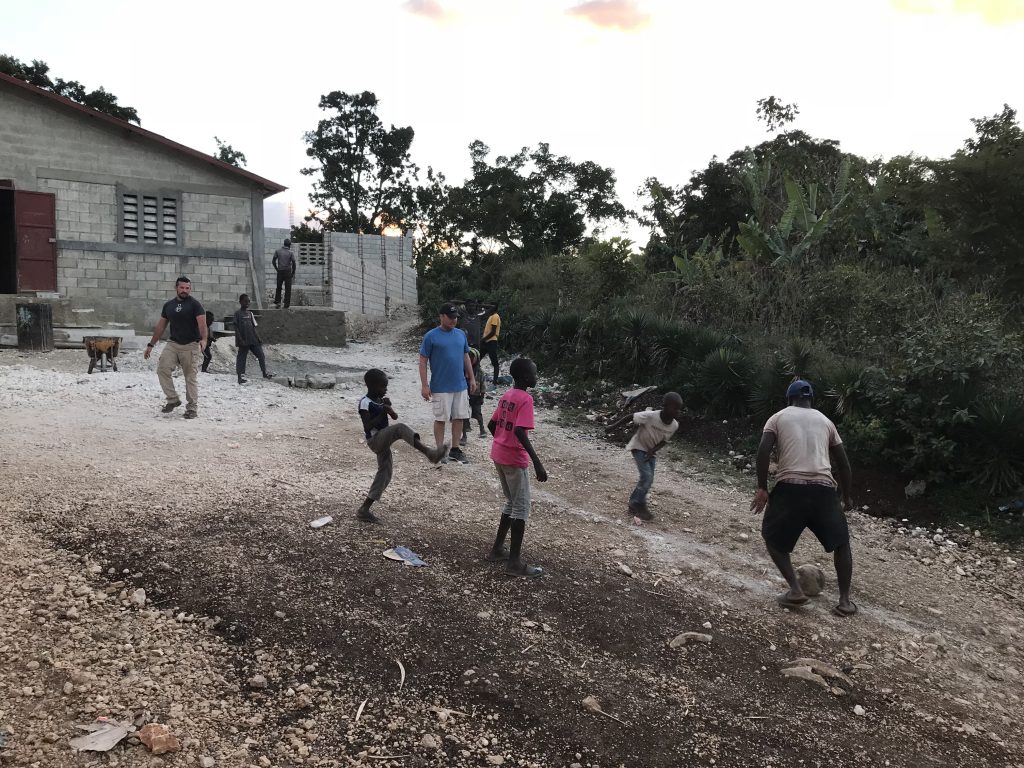
Next to the church is a school built very recently (our first F3 team helped begin that building project a year ago) and a kitchen for both school and church is under construction with its own cistern. Next to these two substantial buildings, the school and church, the homes on ChaCha seem little more than shacks. A handful of newer homes have been built in recent years almost exclusively through the Haiti Under God ministry. Otherwise, though, a typical ChaCha mountain house consists of waddle and daub material (sticks for lath with mud pressed into the cracks to seal it) and a sheet metal roof if one can be afforded. It’s all very primitive by our standards.
That evening our task was really to just settle in. A walking tour of the surroundings to get our bearings and then we set the rest of the afternoon aside to make sure we were ready to go the next morning. And then the sun set and night was upon us. The church keeps a generator around that can be plugged into the church building to provide lights within and enough power to charge batteries for power tools and other needs. So as the sun went down, knowing the American’s were in town, the church quickly filled up to enjoy the unusual pleasure of a well lit space (the sanctuary) while those who had them charged up cell phones and flashlights. This was the pattern every night… while we rolled out air mattresses and sleeping bags across pews within the church, the members of the church hung out around us, laughing and enjoying the perks of our presence.
Finally, as we cut the generator off and, through our translator, sent the locals home, we crept into bed for an early bedtime… the sounds of the night descending upon the quiet confines of the church building.
February 5th, 2018 – Monday
Awoken by the roosters call… which begins at midnight and continues through the wee hours of the morning and into the day… the pax were ready to go by the time the sun brought enough of a glow to the mountain top to enjoy the view of the valley from the church. Chaser had brought a camp stove to heat water for coffee which was augmented by cooks we had with us who also offered up a local brew that morning. Brunch, our first meal of the day, wasn’t for another few hours and so we got to work right from the drop.
While YHC started on a project at the church, Iggy, Apple and Chaser started the day with some block work. Down the mountain, a not easy distance or change in elevation, was the house we were slated to finish while we were there. A prior team had helped pour the slab and block up the walls. It was left to us, therefore, to finish out the higher portions of the walls and get the roofing done. Masonry and roofing not being our highest and best use, these three instead did what F3 guys do nearly every morning somewhere… carry heavy things. AMRAP farmers carry 400 yards and down the trail until all the needed block were in the right spot.
Brunch was our first break and then, having hauled the requisite masonry by then, Apple and Chaser started working on a door for another unfinished project in the neighborhood while Iggy and I spent the bulk of the day building shelving needed in several of the church spaces to allow donations of clothing to be more carefully held in trust for the people of ChaCha and for tools and Haiti Under God gear to be protected in another room. Work with power tools, we found, wasn’t within the normal skillset of the people on the mountain… so our quick work with a powered saw and drill was a unique spectacle for the locals.
Lupper, as we started to call the afternoon/evening meal, was offered us at 4:00 and then we wrapped up the days activities before, exhausted, we started making plans for rest once more. The generator was cranked and into our sleeping quarters (the church… it wasn’t private) came countless kids and adults to enjoy the extended hours of life with electric lights. Having had rough nights and working hard this first full day on ChaCha, nothing could keep the pax from a solid, sound night’s sleep.
February 6th – Tuesday
The roosters had us up early again, well ahead of dawn, and Starbucks instant coupled with the local coffee was enough to get us moving again the next morning at sunrise. We were all starting to get the hang of the sleeping situation, the complications of the facilities and settling into the routine of hard days and long, dark nights.
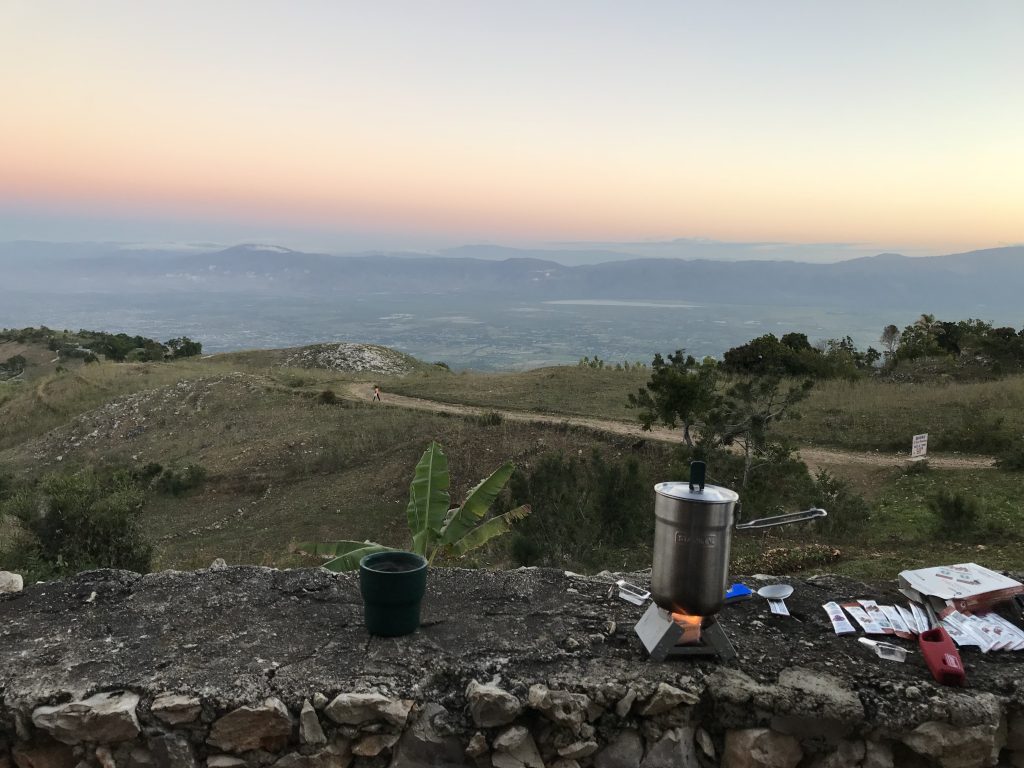
First we completed the two storage spaces for the church before brunch and then, as a team, moved on to another home we were working on that week. A lovely older lady, Andreann, just over the mountain from the church was in dire need of a new roof as well as a new door to her home and so four of us got busy that morning pulling off the old roof. You’d think we’d be pretty good at tearing things up but, in spite of the dilapidation of the roof, the number of leaks and holes that were shining through, the roofing nails came out only with great difficulty. Between a sledge hammer, Sawzall and lots of brute force the dirty work of demolition was completed and prepped for new roof framing and metal which we spent time hauling from the church property over the mountain for the more professional roofing crew among us to execute.
That illustrates a major feature of our time on ChaCha mountain worth explaining. As talented as we all thought we were, we were not, in fact, professionals at Haitian construction and so our tasks were often the brute force work of moving supplies around, hauling bags of cement, loads of lumber and sheet metal. Sticking with our team was a local handyman named Jean-Claude who made sure we didn’t do anything stupid and a translator, Jonelle, who made the most of what we said while continually educating us on the social faux paus we were foisting on the local people.
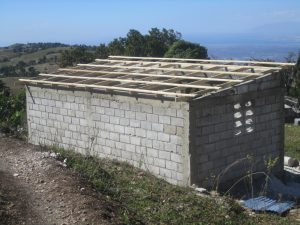
Between the two, who looked after us with just the right balance of humor and chagrin, we managed to get a lot done. Also working on the mountain, employed as part of the team, were two carpenters and a handful of masons. That team was titularly led by Robinson, a familiar face from our past visits to Haiti, who spent much of his time doing the framing and roofing we really weren’t qualified to accomplish well. So, while we would have floundered at our tasks, well meaning though we were, these Haitian brothers put us to good use which was the real reason we were there at all.
Last on Tuesday we hiked up to Grandma Nixon’s house, for whom Chaser and Apple had built a new door, to check out a kitchen house built nearby that we thought we might be qualified to replicate for another needy family.
February 7th – Wednesday
Kitchen’s are smoky and dangerous places in Haiti since everything is cooked over open fires (our own meals as well, of course) and so, as was the case for millennia before the modern kitchen, in Haiti cooking is done away from the one to two room house the people live in. Some Haitians are fortunate to have a real structure while others cook outdoors, no matter the weather, which only works when mother nature cooperates. Therefore, as an effort to help the local people be both safer, more healthy and in effect add on to their living spaces, kitchens are a great way to we can help.
Wednesday before breakfast we pulled together the needed wood and started cutting and framing the pieces necessary to build a kitchen for a family about a quarter mile down the mountain from the church.
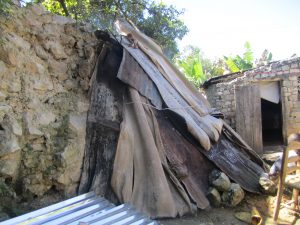
Jenah, who had lost her right eye in an accident well before we arrived, and her husband Herbert had a reasonable home by Haitian standards but were cooking in the insufficient shelter of a sheet of metal leaned against an old rubble wall.
To replace that we built a seven foot by seven foot wood framed building, vented at the top, placed next to their home. Chaser made a number of trips Wednesday morning hauling materials while others of us prepped the framing to minimize the on-site tasks. By mid day we were assembling the structure and before the lupper bell sounded we had tipped it upright and completed 90% of the sheetmetal siding and roofing.
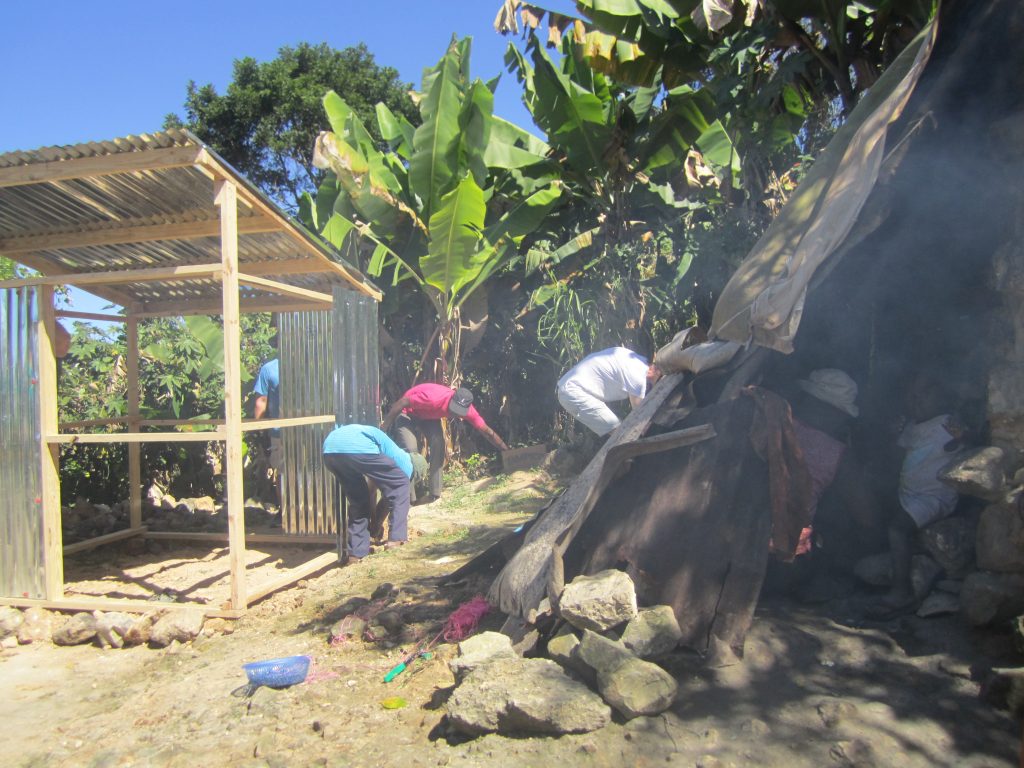
One of the things we’d gotten very comfortable with by then was the constant participation of the local people, especially the amazing number of kids who roam the mountain village. Most of them attend the school which generally begins about the time we break for breakfast. They’re all free by the time we’re wrapping up for our second meal (like most Haitians, we ate only two) so they make us their afternoon entertainment. And the engagement was entirely mutual. It’s amazing the way language barriers are insignificant to kids. And so we spent a lot more time interacting with the youth than the adults.
February 8th – Thursday
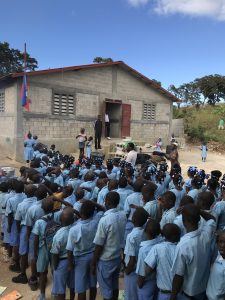
As mentioned, the kids generally (not all, but most) attended the school next to the church and so we got to see them arrive each morning in their blue uniforms and line up for their version of the pledge of allegiance and the national anthem, a hymn and a prayer before they marched into the school building for classes. The teachers spent nights in the church with us and so we got to know a number of them, most of them knowing enough English to engage each evening when we all had a little more spare time. They ran a very orderly operation. Few adults on ChaCha can read or write. Few know more math than might be needed to use what little money comes their way. Education is therefore one of the significant ways Haiti Under God is serving this region.
Thursday turned out to be a mixed day of lighthearted service, some pretty heart wrenching sightseeing and some time out around the area taking in the breathtaking views from the mountainside. First that morning, we went back to the house where we replaced the roof earlier in the week and rebuilt a pair of doors for Andreann to give her a little more security. They have so little that protecting their meager possessions, not to mention keeping out the wildlife, is really a high priority to them. As before she was overwhelmingly appreciative, dancing a bit in thanks (truly, she seemed more delighted with the pair of doors than the entire new roof covering half of her house).
After that Huggy Bear asked if we could take a walk down the mountain a bit to visit a family and potentially look at some future projects for a team or two. Having already put in some good work that day, and knowing what had, with our help, already been accomplished that week, we felt safe taking a day to look around and plan ahead. So off we went, down the hill. Chaser and I climbed a nearby ridge for the view and then met up with the rest of the group as they approached a small hut, mostly sheet metal, bent to try and keep rain out and provide some protection.
It was there that we met Gillaine and Damon, a couple with five children. It was their home we were visiting… the rough metal hut no bigger than a modern office cubicle. Invited to look inside, the one small room was filled with a bed raised up a bit allowing for the seven of them to seek shelter. Seven… two adults and five kids… in an eight by eight corrugated box. 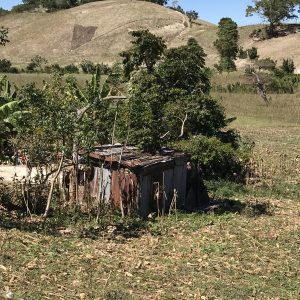
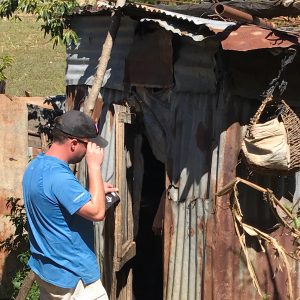
We realized then that we’d been working so far with some of the more fortunate people on ChaCha mountain… people with real homes, though crude, with enough space to sleep and eat and live indoors. While everyone up on ChaCha is poor, this was a new low, a painful reminder that our efforts were mere scratches at the surface of the needs there.
Haiti Under God has a vision for building 40 to 60 new homes, block structures with durable roofs providing protection and shelter. The vision includes providing education to the kids and helping raise the standard of living out of the very real risk of starvation and exposure. We were there in the dry season, the cool season. It’s hard to fathom what it would be like to survive the way Gillaine and Damon do with their family when the storms come or the heat of summer bakes their metal shelter. We have nothing in our American experience that comes close to what every day must be like for them.
Solemn and heartbroken seeing such need we hiked back up to the church and beyond. Frankly we had lost a certain appetite for the labor. What little we had to bring these people and how brash must seem our week-long visit when the comforts of home, for us, were just a few days away.
And so we walked. We walked up and over the mountain trying to shake off the sadness. Surrounded as we were with such amazing views, finally, we were reminded of the pleasures they do have. The day was warm and bright. The people who greeted us still had their joyful smiles. And the mountaintop is truly a breathtaking place to be.
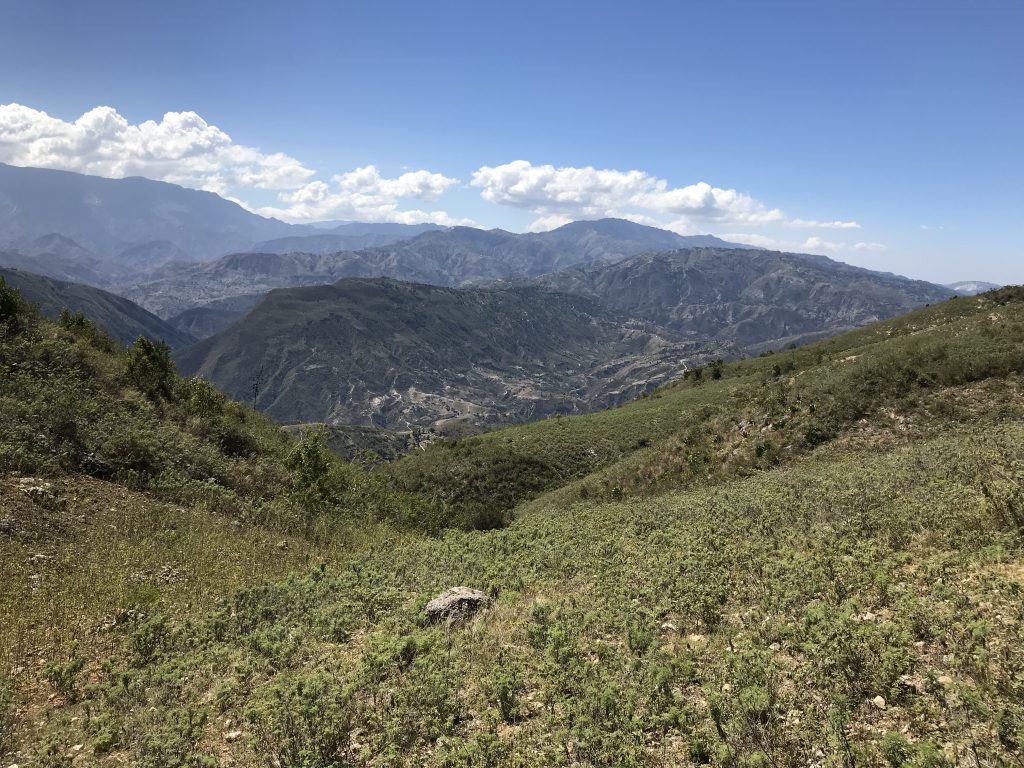
February 9th – Friday
Friday we woke with an urgency to finish well. Grandma Nixon still needed her door hung and there was a nearby cistern that didn’t seem to be collecting rain water properly. There were a few carpentry projects that we could tackle with what little time we had left and so we quickly split up and started knocking out the last little jobs. We also had a good bit of packing to do, much of what we brought we left and so there was a necessary sorting of what we still needed and what we could give to the local people. Chaser and Apple disappeared to find some special kids who’s feet might match our own in size. And there were a lot of good byes to be said to the people we’d met.
We also made a special trip to visit a lady we knew from the last F3 trip to Haiti. Her story is particularly painful and one very personal for us. Since our last time on ChaCha Mountain her husband had been killed when a sand pit collapsed upon him. In fact, Huggy Bear and several other friends had been on ChaCha when it happened and were there for his funeral. As hard as routine life is in Haiti, his passing was devastating. While we were there this time, we found out that this widow and mother had been robbed only a few weeks before we arrived leaving her in debt and uncertain how she would continue to feed herself and children. Recognizing the substantial need, several of or team pooled their resources and, that morning, we all made a trip to give her that very personal financial gift. It was enough to replace what had been stolen and pay the debt in full. What only a few of us had in hand at the time was enough money to make her, financially at least, whole again.
Returning to the church our departure from ChaCha Mountain was fast approaching. I had a tradition to uphold as well and so YHC laced up the running shoes I’d retained and took off ahead of the rest of the caravan for the 10K run from the top of ChaCha down to the bottom, a creek crossing we could remember.
Trucks were loaded up with people and stuff and the long trip down ChaCha began to a fanfare of farewells from the kids as they ran with the departing vehicles. It was a long, slow roll down the mountain, I was told, giving me time to make the trip on foot. Those trucks found me near the bottom and we made our way back to the Valley Church where most of our party unloaded, the local masons coming down the mountain to spend some time working on a hospital building being constructed there.
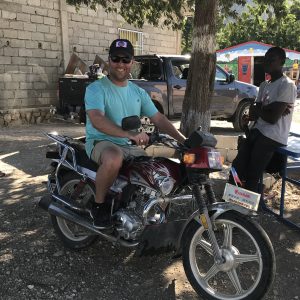
Apple took a motorcycle for a spin with Chaser on the back and we quickly got in the mood to be back closer to home.
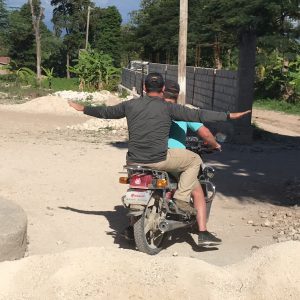
Vehicles again lurched off as we all piled into a dump truck for the last leg of the journey back to Port au Prince and to the Guesthouse.
Never was it so good to roll back into a familiar place, the Guesthouse, where there’s (relatively) reliable electricity and even WiFi, showers with plumbing and toilets that flush, real beds with real sheets. One long military shower later, we were all starting to feel like our old selves again.
February 10th – Saturday
The return to the guesthouse was step one in a long day returning to the lives we put on hold for a week. The morning was relaxed as we all repacked our gear, leaving behind yet more of what we all took for people who need those things far more than we. And, knowing we needed to leave for the PAP airport at 1:00 we took a quick trip beyond the walls of the guesthouse to a place called The Apparent Project. In Haiti, most labor is severely undervalued while materials are still costly. The Apparent Project is a business catering largely to visiting Americans but where local people are paid reasonable wages so that they can feed their families and live a decent life. It’s like an in situ version of fair trade practices you see in stores in the states. They have a gift shop across the street from the series of homes that they turned into a production facility for t-shirts and pottery, local jewelry and crafts. Above the gift shop is cool café with TV’s showing real TV (cricket was on) where 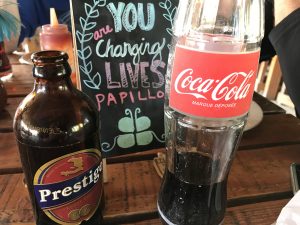 they serve burgers and fries, pizza and cold beer. Though we got there a little after 10:00 that morning, no one was ashamed to order a Prestige (the local Haitian beer we learned, with a certain sadness, was being bought out by Heineken).
they serve burgers and fries, pizza and cold beer. Though we got there a little after 10:00 that morning, no one was ashamed to order a Prestige (the local Haitian beer we learned, with a certain sadness, was being bought out by Heineken).
Lunch was a leisurely affair cut off, finally, to head back to the guest house for our ride down to the airport. An uneventful trip into town and we were dropped off at PAP preparing for our 4:00 flight departure. We went through the typical metal detectors where most of us passed unmolested… Chaser, though, got his bag searched. We had just settled in for a long wait (you don’t want to be late for your flight out of Haiti) when Chaser’s name was called over the intercom. Apparently he was needed for an early pass through the gate security. Thirty minutes later, though, he returned having had his bag searched a second time. Finally, we collected our things and got into the ridiculous line to get checked into the gate. We all had to go through the same bag check and, inexplicably, Chasers ruck got the full treatment again… by the same guy who had checked his bag an hour before.
Finally aboard our flight back to the states, three of us found ourselves comfortably stretched out on the exit row. Three hours later we landed back in Atlanta headed through customs. Iggy had driven to ATL and so he headed off on his own while the remaining four of us headed for the transfer terminal. YHC had to detour into the “special” line but otherwise things moved on… until we had to go through TSA’s security check. For a fourth time in so many hours Chasers ruck got pulled for inspection. And, comically, it turns out it was a TSA goof as they were looking at the xray of someone else’s bag while rifling through everything he had.
One last flight to take and finally the Columbia pax made it home shortly before midnight on that long, last day. Iggy, we learned, made it home safe and sound as did the rest of us thanks to an Uber driver willing to coordinate our carpool. And oh how good that midnight shower felt, hot water for the first time in a week.
NMM:
Many have asked, “How was Haiti?” Haiti is hard. It was a great trip though challenging in many ways. Nothing about going is easy or comfortable. It’s physically demanding both from the hard work done and from the physical complications of going a week without running water or any familiar foods. The trip forms great bonds among the pax but engaging with Haitians, apart from those few who speak English, is a struggle. Yet the greatest challenge rises from the 3rd F.
Most people are prepared for the heart wrenching transition from the comforts we take for granted to the poverty we see in Haiti. And yet the people we meet are often filled with a joy and peace far less common here in the US. Over the course of the week everyone goes through a guilt cycle knowing how much we have and seeing how little people in Haiti have. But somehow in seven days we all adapt and get used to the physical and psychological challenges. What surprises me every time is the return to the states after a week away. Modest as our lifestyles may be relative to our American peers, we live like kings compared to the vast majority of Hatians. It’s emotionally harder to settle back into our old and familiar habits, in many respects, than adapting to life in Haiti.
That is, in fact, why we consider F3Haiti a 3rdF #CSAUP… because the emotional and spiritual challenges of the trip come at you every day, constantly, and stick with you for weeks and months after. It’s impossible to make this kind of trip and come away unchanged. We train for races and rucks, but there is no training adequate to prepare one for Haiti. And it will leave its mark.
We’ll go back. Given the needs apparent on ChaCha alone, we could send a team every week for years to come and still not finish the task. The hardest part is finding the right men and so we must be a little patient. Yes it’s expensive… but that’s not the greatest challenge for most guys to go. It’s the time. We’re all so busy that taking a week away to serve others, a week truly disconnected from our American lives, is a deal killer for most of us. We have the opportunity to transform the life of a whole village… and yet the greatest hurdle to doing so is our natural belief that our lives will fall apart without our constant presence here keeping the train on the tracks. It’s not really true but it’s the challenge we face.
One day soon we’ll start looking at next year. @F3Haiti, Spring 2019. The question is whether you’ll be on that team, or the next one… or the next one… or if your busy life will never let you go. Choose wisely, brothers, the priorities in your life for they are the choices that define you.
